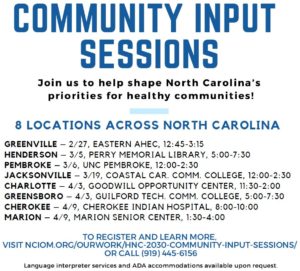

By Brieanne Lyda-McDonald
Since 1990, North Carolina has set 10-year goals for health in the state. These goals are used to determine priorities for action to improve population health for the coming decade. In partnership with the North Carolina Department of Health and Human Services, the North Carolina Institute of Medicine has convened a Task Force and Work Groups to begin the process of selecting health indicators for 2030. The Healthy North Carolina 2030 project will identify approximately 20 indicators to guide population health improvement work over the next decade. The framework for this process is the County Health Rankings model of population health, which identifies the many drivers of health outcomes:
Application of this model to the Healthy North Carolina 2030 project aligns with the growing understanding that these factors play a significant role in the health of individuals and the population as a whole. The role of health equity (the opportunity for all people to achieve health and well-being) will be a major factor in the considerations around indicator selection and target setting for Healthy North Carolina 2030. The Task Force will integrate opportunities to advance health equity and eliminate health disparities into project activities and decisions.
The Health North Carolina 2030 project includes a full Task Force of experts and advocates from around the state who will select health outcome indicators and review the indicators selected by Work Groups in each of the four driver-of-health topic areas. Work Groups will select indicators based on member knowledge and expertise as well as input from community members gathered through community input sessions. There will be eight community input sessions between February 27 and April 9, where lists of potential indicators from each Work Group will be presented, discussed, and ranked on their importance and relevance to communities across the state. These sessions will take place in Guilford, McDowell, Mecklenburg, Onslow, Pitt, Robeson, Swain, and Vance counties. Work Groups will use feedback from the community to inform their final selection of health indicators.

The final list of Healthy North Carolina 2030 health indicators and targets will serve as the State’s Health Improvement Plan for the next decade. The Division of Public Health will be responsible for public reporting through its website, as well as annual updates on progress made. The final Task Force report will be distributed to a wide audience of North Carolinians, including local public health officials, members of the General Assembly, community-based organizations, and other stakeholders. The NCIOM and representatives from the Healthy North Carolina 2030 Task Force plan to present the indicators at the North Carolina Public Health Association’s Fall 2019 conference and the final report at the January 2020 Public Health Leaders’ conference.
Achieving progress toward Healthy North Carolina 2030 objectives will require partnering with policymakers, health professionals, state and local government, insurers, business and community leaders, advocacy organizations, consumer groups, the faith community, and North Carolina’s residents. The selection of indicators will be just the beginning of a decade-long effort to further improve the health of all people in North Carolina. To learn more about Healthy North Carolina 2030, community meetings, and keep informed about progress, visit https://nciom.org/healthy-north-carolina-2030/.